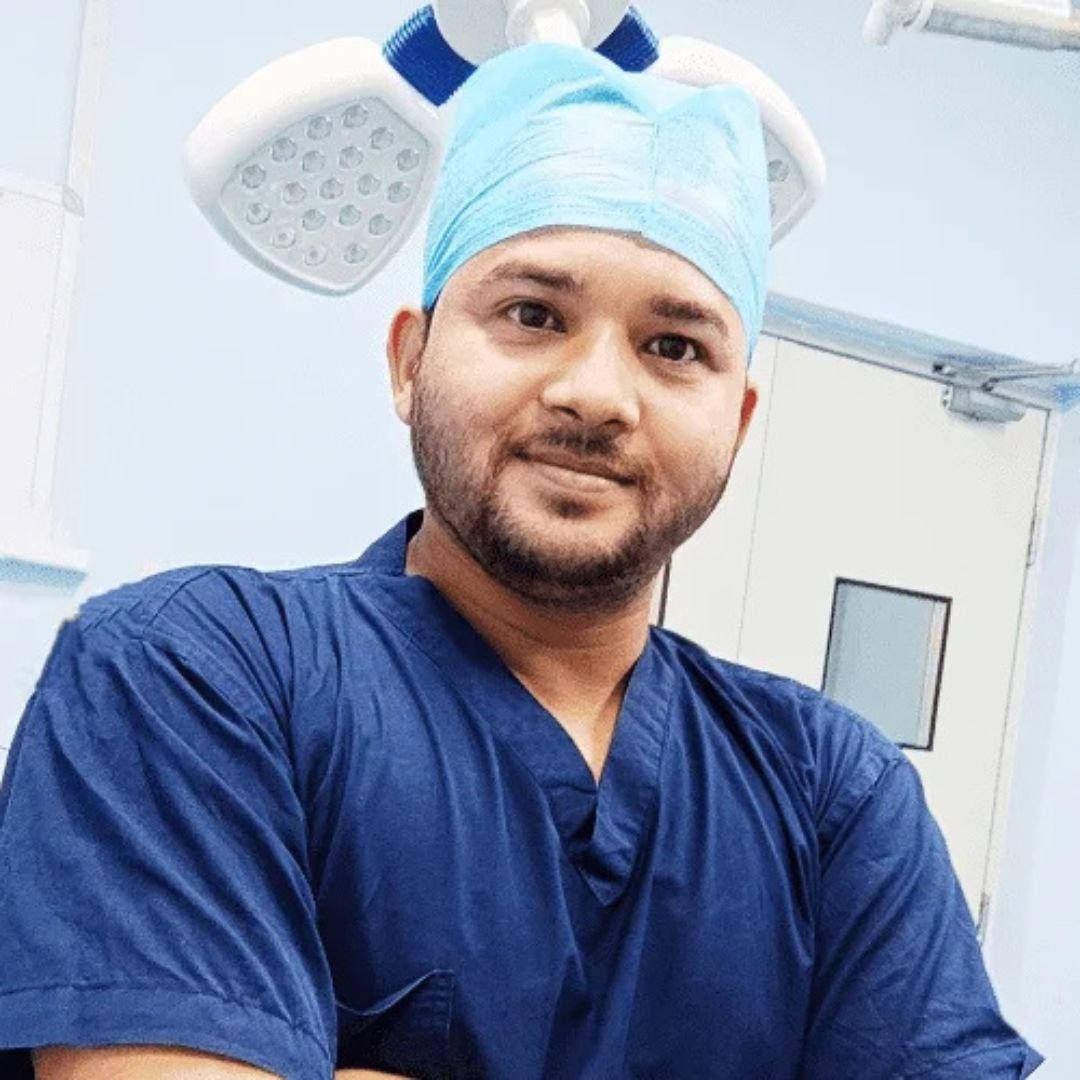Eardrum Repair Surgery - Tympanoplasty
Eardrum repair surgery, medically known as tympanoplasty, is a surgical procedure designed to reconstruct a perforated eardrum (tympanic membrane) or the small bones of the middle ear. This procedure is often recommended for individuals suffering from chronic ear infections, hearing loss, or trauma to the ear. Tympanoplasty is a highly effective solution to restore hearing and prevent recurrent infections. At Bharatkare, we specialize in providing advanced eardrum repair surgery options, ensuring the highest standards of care and successful outcomes.
Book Appointments With Our Expert Doctors Near You
- Get consultation for 50+ diseases across India
- In-person and online consultation with experienced doctors
- Extensive medical assistance throughout your treatment


Dr Ashish Sachdeva
MBBS, MS - General Surgery, General Surgeon, Bariatric Surgeon, Laparoscopic Surgeon
4.9/5
20 Years Experience
Vadodara, India

Dr. Tanmay Jain
General Surgeon, Laparoscopic Surgeon and Proctologist
4.9/5
12 Years Experience
Jaipur, India

Dr. Vikram Vasuniya
MBBS, MS (General Surgery) General Laparoscopic & Laser Surgeon, Laser Proctologist
4.9/5
14 Years Experience
Bhopal, India

Dr. Sujeet Kumar Bharti
MBBS, MS (General Surgery) General Laparoscopic & Laser Surgeon, Laser Proctologist
4.9/5
22 Years Experience
Patna, India
What is Tympanoplasty?
Tympanoplasty is a surgical intervention aimed at repairing a perforated eardrum or addressing issues with the ossicles (tiny bones in the middle ear). The procedure involves grafting tissue onto the eardrum to close the perforation and, if necessary, reconstructing the ossicles to improve hearing.
There are different types of tympanoplasty, classified under the Wullstein classification of tympanoplasty, which range from Type 1 to Type 5. Each type addresses specific issues, such as the extent of eardrum damage or the involvement of the ossicles. For instance, Type 4 tympanoplasty focuses on reconstructing the ossicular chain when the stapes bone is intact.
Tympanoplasty is often confused with myringoplasty, but there is a significant difference between myringoplasty and tympanoplasty. While myringoplasty solely involves repairing the eardrum, tympanoplasty may also include the reconstruction of the middle ear bones. Understanding these distinctions is crucial for patients to make informed decisions about their treatment.
Disease name
Perforated Eardrum
Surgery name
Tympanoplasty
Duration
1 - 2 hours
Treated by
ENT Surgeon (Otolaryngologists)
Best Tympanoplasty Surgery Centers in India
India is renowned for its world-class medical facilities and skilled ENT surgeons, making it a preferred destination for eardrum repair surgery. At Bharatkare, we collaborate with the best tympanoplasty surgery centers in India, equipped with state-of-the-art technology and experienced specialists.
Our network of hospitals and clinics ensures that patients receive personalized care, from diagnosis to post-operative recovery. Whether you require endoscopic tympanoplasty or traditional surgical methods, our centers offer comprehensive solutions tailored to your needs.
Choosing the right center is critical for successful outcomes. Factors such as the surgeon’s expertise, hospital accreditation, and patient reviews should be considered. At Bharatkare, we guide you through every step, ensuring a seamless experience.
What Happens During Tympanoplasty Treatment?
The tympanoplasty procedure is a meticulous process that requires precision and expertise. Here’s a detailed breakdown of the steps of tympanoplasty:
- Anesthesia: The procedure is performed under general or local anesthesia, depending on the patient’s condition and the surgeon’s recommendation.
- Incision: The surgeon makes a small incision behind the ear or inside the ear canal to access the eardrum.
- Graft Placement: A graft for tympanoplasty (often taken from the patient’s own tissue or synthetic material) is placed over the perforation to seal it.
- Ossicular Reconstruction: If the ossicles are damaged, they are repaired or replaced using prosthetic devices.
- Closure: The incision is closed, and the ear is packed with medicated gauze to promote healing.
The entire tympanoplasty procedure steps are performed with utmost care to minimize risks and ensure optimal results.
How to Prepare for a Tympanoplasty?
Preparation is key to a successful tympanoplasty surgery. Here are some essential steps to follow:
- Medical Evaluation: Undergo a thorough medical examination to assess your overall health and identify any potential risks.
- Hearing Tests: Complete audiometric tests to evaluate the extent of hearing loss and eardrum damage.
- Medication Review: Inform your surgeon about any medications or supplements you are taking, as some may need to be discontinued before surgery.
- Fasting: Follow your surgeon’s instructions regarding fasting before the procedure.
- Arrange Transportation: Since the surgery involves anesthesia, arrange for someone to drive you home afterward.
Proper preparation not only ensures a smooth procedure but also reduces the risk of tympanoplasty complications.
What to Expect After a Tympanoplasty?
Post-operative care is crucial for a successful recovery. Here’s what you can expect after eardrum repair surgery:
- Immediate Recovery: You may experience mild pain, dizziness, or a feeling of fullness in the ear. These symptoms are normal and usually subside within a few days.
- Ear Packing: The medicated gauze placed in the ear will be removed during your follow-up visit.
- Hearing Improvement: While some improvement in hearing may be noticed immediately, full recovery can take several weeks as the graft heals.
- Activity Restrictions: Avoid strenuous activities, swimming, or flying for a few weeks to prevent complications.
Understanding the tympanoplasty recovery time and adhering to your surgeon’s instructions can significantly enhance your healing process.
When is a Tympanoplasty Required?
Tympanoplasty indications include:
- Chronic ear infections that do not respond to medication.
- Persistent eardrum perforation causing hearing loss.
- Trauma to the ear leading to eardrum damage.
- Cholesteatoma (an abnormal skin growth in the middle ear).
If you experience symptoms such as ear pain, discharge, or hearing loss, consult a specialist to determine if tympanoplasty is the right solution for you.
What are the Benefits of a Tympanoplasty?
The benefits of eardrum repair surgery are numerous:
- Restored Hearing: Improves hearing by sealing the perforation and reconstructing the middle ear bones.
- Prevention of Infections: Reduces the risk of recurrent ear infections.
- Improved Quality of Life: Enhances overall well-being by alleviating symptoms and restoring normal ear function.
At Bharatkare, we prioritize patient satisfaction and ensure that every tympanoplasty procedure delivers the best possible outcomes.
Recovery Tips After a Tympanoplasty
Recovering from tympanoplasty surgery requires patience and adherence to your surgeon’s guidelines. Here are some essential recovery tips to ensure a smooth healing process:
- Avoid Water Exposure: Keep your ear dry to prevent infections. Use a waterproof earplug while showering or bathing.
- Follow Medication Regimens: Take prescribed antibiotics and pain relievers as directed to manage discomfort and prevent infections.
- Limit Physical Activity: Avoid strenuous activities, heavy lifting, or bending over for at least 2-3 weeks to prevent pressure changes in the ear.
- Sleeping Position: Sleep with your head elevated to reduce swelling and promote drainage.
- Attend Follow-Up Appointments: Regular check-ups are crucial to monitor healing and remove any packing material from the ear.
Understanding the tympanoplasty surgery recovery time is essential. While most patients resume normal activities within 2-4 weeks, complete healing and hearing improvement may take several months.
What is the Cost of Tympanoplasty in India?
The cost of tympanoplasty surgery in India varies depending on factors such as the hospital, surgeon’s expertise, and the complexity of the procedure. At Bharatkare, we provide transparent guidance on the cost structure, ensuring you receive the best value for your investment.
While we do not disclose specific amounts here, we encourage you to contact us for a detailed breakdown tailored to your needs. Our team will assist you in understanding the financial aspects and exploring any available insurance coverage or payment plans.
Understanding Tympanoplasty Complications
While tympanoplasty is generally safe, like any surgical procedure, it carries some risks. Being aware of potential tympanoplasty complications can help you recognize and address them promptly:
- Graft Failure: In some cases, the graft may not heal properly, leading to persistent perforation. Symptoms of tympanoplasty failure include ongoing hearing loss or ear discharge.
- Infection: Post-operative infections can occur if proper care is not taken. Signs include fever, increased pain, or pus discharge.
- Tinnitus: Some patients may experience ringing in the ear, which is usually temporary but can be distressing.
- Hearing Changes: While the goal is to improve hearing, some patients may experience no change or, in rare cases, worsened hearing.
- Dizziness: Temporary dizziness is common after surgery but should resolve within a few days.
At Bharatkare, we prioritize patient safety and take every precaution to minimize these risks.
Endoscopic Tympanoplasty: A Modern Approach
Endoscopic tympanoplasty is a minimally invasive technique that uses an endoscope to visualize and repair the eardrum. This approach offers several advantages:
- Enhanced Precision: The endoscope provides a magnified view of the ear structures, allowing for greater accuracy during the procedure.
- Reduced Trauma: Unlike traditional methods, endoscopic techniques require smaller incisions, resulting in less tissue damage and faster recovery.
- Shorter Hospital Stay: Patients undergoing endoscopic tympanoplasty often experience shorter hospital stays and quicker return to normal activities.
This advanced method is particularly beneficial for patients with complex ear conditions or those seeking a less invasive option.
Steps of Tympanoplasty: A Detailed Breakdown
The tympanoplasty procedure steps are designed to ensure optimal outcomes. Here’s a closer look at each stage:
- Preoperative Assessment: Comprehensive evaluations, including hearing tests and imaging studies, are conducted to plan the surgery.
- Anesthesia Administration: The patient is administered anesthesia to ensure comfort during the procedure.
- Incision and Access: The surgeon makes an incision to access the eardrum and middle ear structures.
- Graft Placement: A graft for tympanoplasty is carefully positioned to seal the perforation.
- Ossicular Reconstruction: If necessary, the ossicles are repaired or replaced using prosthetic devices.
- Closure and Packing: The incision is closed, and the ear is packed with medicated gauze to support healing.
Each step is performed with precision to address the underlying issue and restore ear function.
Wullstein Classification of Tympanoplasty
The Wullstein classification of tympanoplasty is a widely used system to categorize the procedure based on the extent of damage and reconstruction required. Here’s an overview:
- Type 1: Repair of the eardrum without involving the ossicles.
- Type 2: Repair of the eardrum and ossicles, with the malleus bone intact.
- Type 3: Reconstruction of the eardrum and ossicles, with the stapes bone intact.
- Type 4: Reconstruction of the eardrum and ossicles, focusing on the stapes bone.
- Type 5: Creation of a new window in the inner ear to improve sound conduction.
Understanding this classification helps patients and surgeons align on the most appropriate surgical approach.
Difference Between Myringoplasty and Tympanoplasty
While both procedures aim to repair the eardrum, there are key differences between myringoplasty and tympanoplasty:
- Scope: Myringoplasty focuses solely on closing the eardrum perforation, while tympanoplasty may also involve reconstructing the middle ear bones.
- Complexity: Tympanoplasty is generally more complex and may require longer recovery time.
- Indications: Myringoplasty is suitable for simple perforations, whereas tympanoplasty is recommended for more extensive damage.
At Bharatkare, we assess each patient’s condition to determine the most suitable procedure.
Tympanoplasty Recovery Time: What to Expect
The tympanoplasty recovery time varies depending on the complexity of the procedure and the patient’s overall health. Here’s a detailed timeline to help you understand what to expect:
- First Week:
- Mild pain, dizziness, and a feeling of fullness in the ear are common.
- Avoid blowing your nose or sneezing forcefully to prevent pressure changes in the ear.
- Keep the ear dry and follow all post-operative care instructions.
- 2-4 Weeks:
- Most patients can resume light activities but should avoid strenuous exercise or heavy lifting.
- Hearing may gradually improve, but full recovery can take several weeks.
- 6-8 Weeks:
- By this time, the graft should be fully healed, and hearing improvement becomes more noticeable.
- Follow-up appointments are essential to monitor progress and address any concerns.
- 3-6 Months:
- Complete healing and stabilization of hearing occur during this period.
- Patients are advised to continue protecting the ear from water and trauma.
Understanding the tympanoplasty surgery recovery time helps set realistic expectations and ensures a smoother healing process.
Tympanoplasty Failure Symptoms: Recognizing the Signs
While tympanoplasty has a high success rate, there are instances where the procedure may not achieve the desired results. Recognizing tympanoplasty failure symptoms early can help address issues promptly:
- Persistent Hearing Loss: If hearing does not improve or worsens after surgery, it may indicate graft failure or improper healing.
- Recurrent Ear Infections: Frequent infections or discharge from the ear could signal a problem with the graft.
- Ear Pain or Discomfort: Ongoing pain or discomfort may indicate an infection or other complications.
- Tinnitus: Persistent ringing in the ear could be a sign of unresolved issues.
- Visible Perforation: If the eardrum perforation remains visible during follow-up examinations, further intervention may be required.
At Bharatkare, we emphasize post-operative care and regular follow-ups to minimize the risk of tympanoplasty failure.
Tympanoplasty Indications: When is Surgery Necessary?
Tympanoplasty indications include a range of conditions that affect the eardrum and middle ear. Here’s a closer look at when this procedure is recommended:
- Chronic Otitis Media: Persistent middle ear infections that do not respond to medication.
- Traumatic Perforations: Eardrum damage caused by injury or trauma.
- Cholesteatoma: An abnormal skin growth in the middle ear that can lead to hearing loss and infections.
- Hearing Loss: Significant hearing impairment due to eardrum perforation or ossicular damage.
- Ear Discharge: Continuous discharge from the ear that affects quality of life.
If you experience any of these symptoms, consult a specialist to determine if tympanoplasty is the right solution for you.
Graft for Tympanoplasty: Materials and Techniques
The success of tympanoplasty largely depends on the graft for tympanoplasty used to repair the eardrum. Here’s an overview of the materials and techniques involved:
- Autografts: Tissue taken from the patient’s own body, such as the temporalis fascia or tragus cartilage.
- Allografts: Donor tissue that has been processed and sterilized for use.
- Synthetic Materials: Advanced materials like silicone or bioengineered tissues.
The choice of graft depends on factors such as the size of the perforation, the patient’s medical history, and the surgeon’s preference. At Bharatkare, we use the most suitable graft materials to ensure optimal outcomes.
Tympanoplasty Procedure: A Step-by-Step Guide
The tympanoplasty procedure is a carefully planned and executed surgery. Here’s a detailed guide to the steps of tympanoplasty:
- Preoperative Preparation:
- Comprehensive evaluations, including hearing tests and imaging studies, are conducted.
- The patient is briefed on the procedure and post-operative care.
- Anesthesia:
- General or local anesthesia is administered to ensure patient comfort.
- Incision and Access:
- A small incision is made behind the ear or inside the ear canal to access the eardrum.
- Graft Placement:
- The chosen graft for tympanoplasty is positioned over the perforation and secured in place.
- Ossicular Reconstruction:
- If the ossicles are damaged, they are repaired or replaced using prosthetic devices.
- Closure and Packing:
- The incision is closed, and the ear is packed with medicated gauze to support healing.
- The incision is closed, and the ear is packed with medicated gauze to support healing.
Each step is performed with precision to address the underlying issue and restore ear function.
Type 4 Tympanoplasty: A Specialized Approach
Type 4 tympanoplasty is a specialized procedure within the Wullstein classification of tympanoplasty. It focuses on reconstructing the ossicular chain when the stapes bone is intact. Here’s what makes this approach unique:
- Targeted Reconstruction: The procedure aims to create a functional connection between the eardrum and the stapes bone.
- Complexity: Type 4 tympanoplasty is more complex than other types and requires advanced surgical skills.
- Outcomes: When successful, this procedure can significantly improve hearing and prevent recurrent infections.
At Bharatkare, our experienced surgeons are well-versed in performing type 4 tympanoplasty and other advanced ear surgeries.
Endoscopic Tympanoplasty: Advantages and Applications
Endoscopic tympanoplasty is a modern, minimally invasive technique that offers several advantages over traditional methods:
- Enhanced Visualization: The endoscope provides a clear, magnified view of the ear structures, allowing for greater precision.
- Reduced Trauma: Smaller incisions result in less tissue damage and faster recovery.
- Versatility: This technique can be used for a wide range of ear conditions, including complex cases.
Patients undergoing endoscopic tympanoplasty often experience shorter hospital stays and quicker return to normal activities.
Questions to Ask Your Surgeon
Before undergoing eardrum repair surgery, it’s important to have a clear understanding of the procedure and its outcomes. Here are some questions to discuss with your surgeon:
- What type of tympanoplasty is recommended for my condition?
- Understanding the tympanoplasty types and the Wullstein classification of tympanoplasty can help you grasp the specifics of your surgery.
- What are the potential risks and complications?
- Discussing tympanoplasty complications such as graft failure, infection, or hearing changes will help you prepare for all scenarios.
- What is the expected recovery timeline?
- Clarifying the tympanoplasty recovery time and post-operative care requirements is crucial for planning your recovery.
- What are the success rates of this procedure?
- Knowing the likelihood of success and potential tympanoplasty failure symptoms can help set realistic expectations.
- Are there alternatives to tympanoplasty?
- Exploring options such as myringoplasty vs tympanoplasty can help you make an informed decision.
- Exploring options such as myringoplasty vs tympanoplasty can help you make an informed decision.
Asking these questions will empower you to approach the surgery with confidence and clarity.
Benefits of Tympanoplasty: Why Choose This Procedure?
Tympanoplasty offers numerous benefits for patients suffering from eardrum perforations or middle ear issues. Here’s a detailed look at why this procedure is highly recommended:
- Restored Hearing: By sealing the eardrum perforation and reconstructing the ossicles, tympanoplasty significantly improves hearing.
- Prevention of Infections: A repaired eardrum reduces the risk of recurrent ear infections, which can lead to further complications.
- Improved Quality of Life: Patients often experience relief from symptoms like ear pain, discharge, and hearing loss, leading to a better overall quality of life.
- Long-Term Solution: Unlike temporary fixes, tympanoplasty provides a permanent solution for chronic ear issues.
- Minimal Scarring: With advanced techniques like endoscopic tympanoplasty, the procedure leaves minimal scarring and ensures faster recovery.
At Bharatkare, we prioritize patient well-being and ensure that every tympanoplasty procedure delivers these benefits effectively.
Preparing for Tympanoplasty: A Comprehensive Guide
Proper preparation is essential for a successful tympanoplasty surgery. Here’s a step-by-step guide to help you get ready:
- Medical Evaluation:
- Undergo a thorough medical examination to assess your overall health and identify any potential risks.
- Inform your surgeon about any existing medical conditions or allergies.
- Hearing Tests:
- Complete audiometric tests to evaluate the extent of hearing loss and eardrum damage.
- Imaging studies like CT scans may be required to assess the middle ear structures.
- Medication Review:
- Discuss all medications and supplements you are taking with your surgeon.
- Certain medications, such as blood thinners, may need to be discontinued before surgery.
- Lifestyle Adjustments:
- Avoid smoking and alcohol consumption, as they can interfere with the healing process.
- Maintain a healthy diet to boost your immune system and promote faster recovery.
- Logistical Planning:
- Arrange for someone to drive you home after the surgery, as anesthesia may impair your ability to drive.
- Plan for time off work or school to allow for adequate rest and recovery.
By following these preparation steps, you can ensure a smooth and successful tympanoplasty procedure.
Tympanoplasty Complications: Understanding the Risks
While tympanoplasty is generally safe, it’s important to be aware of potential complications. Here’s a detailed look at the risks associated with this procedure:
- Graft Failure:
- In some cases, the graft may not heal properly, leading to persistent perforation. Symptoms of tympanoplasty failure include ongoing hearing loss or ear discharge.
- Infection:
- Post-operative infections can occur if proper care is not taken. Signs include fever, increased pain, or pus discharge.
- Tinnitus:
- Some patients may experience ringing in the ear, which is usually temporary but can be distressing.
- Hearing Changes:
- While the goal is to improve hearing, some patients may experience no change or, in rare cases, worsened hearing.
- Dizziness:
- Temporary dizziness is common after surgery but should resolve within a few days.
- Temporary dizziness is common after surgery but should resolve within a few days.
At Bharatkare, we take every precaution to minimize these risks and ensure a safe and successful procedure.
Endoscopic Tympanoplasty: A Modern Approach to Ear Surgery
Endoscopic tympanoplasty is a minimally invasive technique that uses an endoscope to visualize and repair the eardrum. Here’s why this approach is gaining popularity:
- Enhanced Precision:
- The endoscope provides a magnified view of the ear structures, allowing for greater accuracy during the procedure.
- Reduced Trauma:
- Unlike traditional methods, endoscopic techniques require smaller incisions, resulting in less tissue damage and faster recovery.
- Shorter Hospital Stay:
- Patients undergoing endoscopic tympanoplasty often experience shorter hospital stays and quicker return to normal activities.
- Versatility:
- This technique can be used for a wide range of ear conditions, including complex cases.
- This technique can be used for a wide range of ear conditions, including complex cases.
At Bharatkare, we specialize in endoscopic tympanoplasty, offering patients a modern and effective solution for eardrum repair.
Wullstein Classification of Tympanoplasty: A Detailed Overview
The Wullstein classification of tympanoplasty is a widely used system to categorize the procedure based on the extent of damage and reconstruction required. Here’s an overview of each type:
- Type 1:
- Repair of the eardrum without involving the ossicles.
- Type 2:
- Repair of the eardrum and ossicles, with the malleus bone intact.
- Type 3:
- Reconstruction of the eardrum and ossicles, with the stapes bone intact.
- Type 4:
- Reconstruction of the eardrum and ossicles, focusing on the stapes bone.
- Type 5:
- Creation of a new window in the inner ear to improve sound conduction.
- Creation of a new window in the inner ear to improve sound conduction.
Understanding this classification helps patients and surgeons align on the most appropriate surgical approach.
Difference Between Myringoplasty and Tympanoplasty
While both procedures aim to repair the eardrum, there are key differences between myringoplasty and tympanoplasty:
- Scope:
- Myringoplasty focuses solely on closing the eardrum perforation, while tympanoplasty may also involve reconstructing the middle ear bones.
- Complexity:
- Tympanoplasty is generally more complex and may require longer recovery time.
- Indications:
- Myringoplasty is suitable for simple perforations, whereas tympanoplasty is recommended for more extensive damage.
- Myringoplasty is suitable for simple perforations, whereas tympanoplasty is recommended for more extensive damage.
At Bharatkare, we assess each patient’s condition to determine the most suitable procedure.
FAQ
You Can Find All Answers Here
The success rate of tympanoplasty is generally high, ranging from 85% to 95%, depending on factors such as the patient’s overall health and the extent of ear damage.
The tympanoplasty procedure typically takes 1 to 2 hours, depending on the complexity of the case.
Most patients experience mild discomfort after the procedure, which can be managed with prescribed pain medications.
Yes, children can undergo tympanoplasty if they have chronic ear infections or eardrum perforations that affect their hearing.
Symptoms of tympanoplasty failure include persistent hearing loss, recurrent ear infections, and ear discharge.
Most patients can return to work within 1-2 weeks, depending on the nature of their job and the extent of the surgery.
Discussing tympanoplasty complications such as graft failure, infection, or hearing changes will help you prepare for all scenarios.
Clarifying the tympanoplasty recovery time and post-operative care requirements is crucial for planning your recovery.
Knowing the likelihood of success and potential tympanoplasty failure symptoms can help set realistic expectations.
Exploring options such as myringoplasty vs tympanoplasty can help you make an informed decision.
Quick Links
Popular Surgeries
Find Us
© Copyright BharatKare 2025. All Right Reserved.



